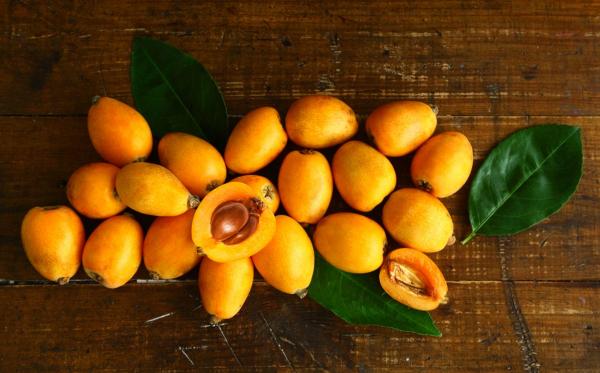Dripping Gardening April 30

For me, if there’s anything more beautiful than wildflowers right now, it’s those yellowish orange fruits growing on deep-green trees that you can find all over central Texas. I am talking about loquats, which despite the name, are unrelated to kumquats but are equally as tasty.
If your only experience of loquat fruit has come from the dessert bar at a Chinese buffet, you don’t know what you been missing! Those little, syrup-canned spheres most likely came from Japan, Israel, or Brazil. Because fresh loquats bruise and spoil easily, they had to travel processed and canned, and these, while good are not nearly as tasty as one picked right off the tree. Unprocessed, they’re nutritional powerhouses well worth growing in your yard.
Still not familiar with the fruit I’m talking about? You are not alone. While once a staple in the Texas frontier diet, the loquat or Japanese plum, fell out of favor as other fruits became more available to consumers. The plant is extremely cold hardy and is now grown more as an ornamental from north Texas to the Valley. Fortunately for those of us that love them, loquats are making a comeback. Although the loquat is one of the more familiar of all tropical fruit plants in Texas, few people outside of south Texas have ever actually grown the fruit.
If you are wondering exactly what a loquat is, I can help as it is one of my springtime favorites. Loquats (Eriobotrya japonica) are trees that produce small, round or pear-shaped fruits, rarely more than 2 inches long. Sweet or slightly acidic in flavor, the juicy flesh may be white, yellow or orange with a yellow or orange-blushed peel. Loquats are tasty when peeled and eaten fresh, or you can freeze the whole fruit for later use. They make excellent jellies, jams, preserves, cobblers and pies.
Unlike pear, peach or pecan trees that also grow well here, loquat trees are often considered ornamental because they don’t regularly bear fruit and the fruit can be small and finicky to peel and pit. (Also because they bloom in late winter, they are particularly vulnerable to late freezes.) Some homeowners consider them a nuisance because they attract so many squirrels and birds, and the fruit that the animals don’t eat rots off the trees and can cause a bit of a mess.
Lucky for me, last summer’s terrible dry & hot spell, and the warm-wet winter we have just had, means more loquats than usual this year. That is because after a long period of distress, trees will often produce more fruit than necessary in an attempt to ‘ensure’ a next generation.
I prefer to peel the skin off, but my brother is just as happy to pop the whole thing in his mouth and spit out the skin and seeds. The loquats that grow around here can have pretty large seeds compared with the cultivated varieties elsewhere, but they are easy to pop out.
If you aren’t lucky enough to have your own loquat tree, you’ll have to ask others for some of their fruit as you will not find them at the local grocery store. It’s illegal, not to mention unsafe, to go onto someone’s property and pick their loquats without their permission-- but door-to-door foraging isn’t your only option. At least a few of your Facebook or Twitter friends will have loquat trees, so consider asking around on social media, and since the trees usually produce way more fruit than a single family can use, most folks are glad to allow you to pick some.
I can easily go through more than 25 pounds of loquats each season, making everything from jelly to “pico de gallo.” (Hint: These fruits, especially the underripe ones, have quite a bit of pectin, so you often do not need to add commercial pectin to help the jam, preserves or jelly set.)
Another great way to incorporate loquat into your diet is to combine diced loquats with onions, ginger, allspice, sugar, vinegar and chiles to make a loquat chutney, which is delicious on chicken and pork. Several years ago, I found a restaurant in downtown Austin serving a salted caramel loquat ice cream - and it was wonderful! My brother makes a loquat bourbon punch that is scrumptious and makes me wonder about other loquat libations that might be possible.
It’s pretty easy to turn a few handfuls of the fruit into a simple syrup, too. Slice off the end of the fruit that has the dried blossom still attached, pop out the pits and cover the fruit, skin on, with water. Bring to a boil, reduce heat and simmer for about 15 to 20 minutes. Use a potato masher to squeeze out the juice from the flesh, then use a colander to separate the skins and flesh from the liquid. Measure how much liquid you have and add an equal amount of sugar. Bring to a boil, let cool, and enjoy it as a sweetener in lemonade and iced tea.
I hope I have convinced you to add loquat to your yard. But if you don’t want a tree you will be happy to know that you can also grow loquats, planted closely together, as a hedge.
Caring for a loquat properly, whether tree or shrub, begins with its planting. When growing loquat plants, you should place them in a sunny location at least 25 to 30 feet from structures, electrical lines and other trees. When you remove the sapling from its container, rinse off some of the growing medium so that when you plant the tree, the roots come in direct contact with the soil. Plant the tree so that the soil line of the tree is even with the level of the surrounding soil. Water the tree twice the first week after planting and keep the soil lightly moist around the tree until it begins to put on new growth.
Growing loquat fruit trees and their care focuses on good nutrition, water management and weed control. Fertilize the trees three times a year with a lawn fertilizer that does not contain weed killers. In the first year, use a cup of fertilizer divided into three applications spread over the growing season. In the second and third years, increase the annual amount of fertilizer to two cups. Scatter the fertilizer on the ground and water it in. Water a loquat tree when the blossoms begin to swell in spring and two to three more times when the fruit begins to ripen. Apply the water slowly, allowing it to sink into the soil as much as possible. Stop when the water begins to run off. Young trees don’t compete well with weeds, so maintain a weed-free area that extends two to three feet from the trunk of the tree. Take care when cultivating around the tree because the roots are shallow. A layer of mulch will help keep weeds at bay.
Now, while we are all stuck in our homes, is the perfect time to experiment with this underappreciated fruit. Who knows when we’ll have as good a crop again and they probably won’t cost you a dime. Sure, you might have to drum up the courage to ask a neighbor you’ve never met if you can pick a pound or two from his or her tree, but maybe you’ll make a new acquaintance while you’re at it – just remember to do it while following safe social distancing guidelines!
Joe Urbach is the publisher of GardeningAustin.com and the Phytonutrient Blog. He has lived in the Central Texas area for over 30 years.


